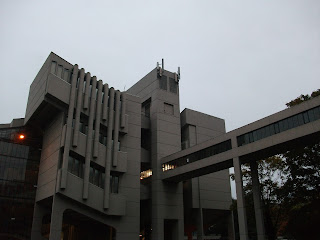Incidentally, that part of the City Centre, including the Merrion Centre itself, features more of the same combination of imposing architecture and pioneering underpasses which are somewhere between Soviet and science fiction in style. Much of this being now discredited, the underpasses are boarded-up and the whole area is seemingly being prepared for regeneration around the forthcoming Leeds Arena, which is effectively on the site of the Brunswick Building.
So the University of Leeds campus remains an unused set, at least for sci-fi purposes, having last featured in an episode of Raffles (the gentleman thief) in the heady days of the 1970s. However, another Yorkshire Television production, a 1979 adaptation of the M.R. James story Casting the Runes, used the University’s Brotherton Library. It had first been filmed under the title Night of the Demon, in 1957, when the corresponding – and original – scene took place in the British Library. My own images, taken recently around the landmark Roger Stevens Building (completed in 1970), and featuring the walkway which connects to the enigmatically named Red Route – allegedly the longest corridor in Europe, unless that is of course another urban myth – attempt to suggest locations for a script yet to be written. Taking these photographs, speculating about the films which weren’t filmed here after all, and ones which might still be, also enlivened the monotony of the daily walk to work.
Watch the trailer for the 1979 TV adaptation of M.R. James' Casting the Runes on Youtube: http://www.youtube.com/watch?v=8rPvmFnUCgk (featuring the Brotherton Library)



